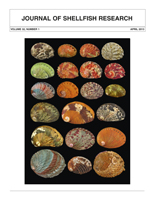The effect of different strategies of opening water flow on the survival and growth of Haliotis rufescens 9-d postlarvae was evaluated using a randomized block design with 3 replicates for 63 days. Larvae were settled (1.5 µM gamma-aminobutyric acid) in 2-L plastic vessels (total area, 701 cm2) and were subjected to the following treatments: static conditions, static conditions with aeration (NF A), flow opened after 10 d, flow opened after 17 d, and flow opened after 24 d. The experiment was conducted at constant temperature (17.5 ± 0.5°C) and light intensity (∼750 lux). Water was changed daily in static treatments, and flow treatments received filtered seawater at ∼60 mL/min. Postlarvae were fed the benthic diatom Navicula incerta per standardized protocols. Every week, all organisms in each experimental unit were counted to estimate survival, and samples of 15 postlarvae were recorded under an inverted microscope and measured using digital image analysis. At the end of the experiment, greater survival occurred in treatment NF A (68.2%) and was the lowest in the treatment in which flow was opened after 10 days (26.9%); however, no significant differences were found (P > 0.37). The greatest growth rate was observed in the treatment in which flow was opened after 24 days (61.6 µm/d), and the lowest was seen in static conditions (47.6 µm/d and 44.6 µm/d for static conditions and NF A treatments, respectively). An inverse relationship between final growth rates and postlarval densities was found. Our results suggest that abalone postlarvae can be cultured successfully in static conditions with aeration, but feeding routines should be improved to allow high growth rates at high stocking densities.
How to translate text using browser tools
1 April 2013
Survival and Growth of Red Abalone (Haliotis rufescens) Postlarvae Under Different Static and Flow Conditions
Casandra Anguiano-Beltrán,
Ricardo Searcy-Bernal
ACCESS THE FULL ARTICLE

Journal of Shellfish Research
Vol. 32 • No. 1
April 2013
Vol. 32 • No. 1
April 2013
aeration
Haliotis rufescens
postlarval growth
postlarval survival
red abalone
static conditions
water flow




